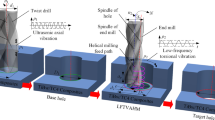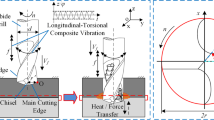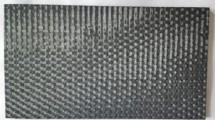Abstract
Titanium Matrix Composites (TMCs) are widely used in aerospace because of their excellent mechanical properties, but it is accompanied by the difficulty of machining. Ultrasonic Vibration Assisted Drilling (UVAD) can effectively reduce the axial force in the drilling process and improve the integrity of machined surface. In this paper, the discontinuous titanium matrix composite TiBw/TC4 was developed by preparation method of in situ. In order to obtain the machining parameters of TiBw/TC4 and guide the application of UVAD in TiBw/TC4, the contrast experiments between conventional drilling (CD) and UVAD were carried out to analyze the variation law of axial force. In this experiment, the frequency and amplitude of ultrasonic vibration were set as 35 kHz and 2.5 μm respectively, and the drilling conditions were that the spindle speed was (1500/1600/1700/1800/1900) r/min and the feed speed was (6/7/8/9/10) mm/min. The surface integrity of hole wall such as roughness, residual stress and white layer was discussed. The experimental results show that the yield strength of TiBw/TC4 developed by in situ is 51% higher than that of pure TC4. Compared with CD, the axial force of TiBw/TC4 in UVAD is significantly reduced, and the formation of continuous chips and winding cutters is effectively reduced. Besides, the wear rate of the cutters is reduced. The number and size of hole wall defects, such as scratches, delamination and tearing, are obviously reduced. As well as the residual stress, white layer thickness and hole wall roughness are reduced by 4.67–16.31%, 42.48% and 5.98–29.27% respectively. Within the limits of the experiment, when the spindle speed is 1700 r/min and the feed speed is 8 mm/min, UVAD can obtain better hole wall surface integrity parameters.
















Similar content being viewed by others
References
Brewer, W. D., Bird, R. K., & Wallace, T. A. (1998). Titanium alloys and processing for high speed aircraft. Materials Science and Engineering A,243, 299–304.
Choi, H. J., Park, C. W., Kang, I. S., Kim, J. S., & Choi, S. D. (2016). Material model application considering strain softening for cutting simulation of Ti–6Al–4V alloy and its experimental validation. International Journal of Precision Engineering and Manufacturing,17, 1651–1658.
Tabie, V. M., Shi, X., Li, J., Cai, C., & Xu, X. (2019). Tribological properties of Ti–4Si–xZr–yY2O3/5TiO2 composites prepared by high-energy milling, cold pressing and sintering. International Journal of Precision Engineering and Manufacturing,20, 1929–1937.
You, S. H., Lee, J. H., & Oh, S. H. (2019). A study on cutting characteristics in turning operations of titanium alloy used in automobile. International Journal of Precision Engineering and Manufacturing,20, 209–216.
Hayat, M. D., Singh, H., He, Z., & Cao, P. (2019). Titanium metal matrix composites: An overview. Composites Part A Applied Science and Manufacturing,121, 418–438.
Chandran, K. S. R., Panda, K. B., & Sahay, S. S. (2004). TiBw -reinforced Ti composites: Processing, properties, application prospects, and research needs. JOM Journal of the Minerals Metals and Materials Society,56, 42–48.
Marte, J. S., Kampe, S. L., & Wereszczak, A. A. (2003). Elevated temperature deformation behavior of discontinuous-reinforced titanium aluminide matrix composites. Materials Science and Engineering A,346, 292–301.
Shyu, R. F., & Ho, C. T. (2006). In situ reacted titanium carbide-reinforced aluminum alloys composite. Journal of Materials Processing Technology,171, 411–416.
Dong, L. L., **ao, B., Liu, Y., Li, Y. L., Fu, Y. Q., Zhao, Y. Q., & Zhang Y. S. (2018). Sintering effect on microstructural evolution and mechanical properties of spark plasma sintered Ti matrix composites reinforced by reduced graphene oxides. Ceramics International, 44, 17835–17844. https://doi.org/10.1016/j.ceramint.2018.06.252.
Lee, W. H., Seong, J. G., Yoon, Y. H., Jeong, C. H., Tyne, C. J. V., & Lee, H. G. (2019). Synthesis of TiC reinforced Ti matrix composites by spark plasma sintering and electric discharge sintering: A comparative assessment of microstructural and mechanical properties. Ceramics International,45, 8108–8114.
Yang, Z. R., Huan, H. X., Jiang, C. F., Li, W. M., Liu, X. R., & Lyu, S. (2017). Evaluation on dry sliding wear behavior of (TiB + TiC)/Ti–6Al–4V matrix composite. International Journal of Precision Engineering and Manufacturing,18, 1139–1146.
Qin, Y., & Ni, D. (2011). Dry sliding wear behavior of extruded titanium matrix composite reinforced by in situ TiB whisker and TiC particle. Journal of Materials Science,46, 4980–4985.
Morsi, K., & Patel, V. V. (2007). Processing and properties of titanium–titanium boride (TiBw) matrix composites—a review. Journal of Materials Science,42, 2037–2047.
Kamiya, A., Shi, W., Watazu, A., Zhu, J., & Naganuma, K. (2001). Alumina chopped fiber reinforced titanium matrix composite fabrication by hot-press method. Journal of Materials Science Letters,20, 1189–1191.
Hausmann, J. M., Leyens, C., & Kaysser, W. A. (2004). Interaction between cyclic loading and residual stresses in titanium matrix composites. Journal of Materials Science,39, 501–509.
David, R., Shrivastava, V., Dasgupta, R., Prasad, B. K., & Singh, I. B. (2019). Corrosion investigation of zinc-aluminum alloy (ZA-27) matrix reinforced with in situ synthesized titanium carbide particle composites. Journal of Materials Engineering and Performance,28, 2356–2364.
Hsu, I., & Tsao, C. C. (2009). Study on the effect of frequency tracing in ultrasonic-assisted drilling of titanium alloy. International Journal of Advanced Manufacturing Technology,43, 127–135.
Liu, J. W., Baek, D. K., & Ko, T. J. (2014). Chip** minimization in drilling ceramic materials with rotary ultrasonic machining. International Journal of Advanced Manufacturing Technology,72, 1527–1535.
Moghaddas, M. A., Short, M. A., Wiley, N. R., Yi, A. Y., & Graff, K. F. (2018). Performance of an ultrasonic-assisted drilling module. The International Journal of Advanced Manufacturing Technology,94, 3019–3028.
Paktinat, H., & Amini, S. (2017). Ultrasonic assistance in drilling: FEM analysis and experimental approaches. International Journal of Advanced Manufacturing Technology,92, 2653–2665.
Shan, C., Zhang, X., Dang, J., & Yang, Y. (2018). Rotary ultrasonic drilling of needle-punched carbon/carbon composites: comparisons with conventional twist drilling and high-speed drilling. International Journal of Advanced Manufacturing Technology, 98, 189–200. https://doi.org/10.1007/s00170-017-1228-7.
Wang, Y., Lin, B., Dong, Y., Zhao, J., & Ouyang, J. (2019). Mechanism modeling and validation in ultrasonic vibration assisted drilling with variable cross section drilling tool of brittle materials. International Journal of Advanced Manufacturing Technology, 103, 1–13. https://doi.org/10.1007/s00170-019-03762-7.
Rielli, V. V., Amigó-Borrás, V., & Contieri, R. J. (2019). Microstructural evolution and mechanical properties of in situ as-cast beta titanium matrix composites. Journal of Alloys and Compounds, 778, 186–196. https://doi.org/10.1016/j.jallcom.2018.11.093.
Wang, B., Zhang, H. B., Huang, L. J., He, J. L., Zhang, Y. F., & Wang, W. (2018). Evolution of microstructure and high temperature tensile properties of as-extruded TiBw reinforced near-α titanium matrix composite subjected to heat treatments. Science China Technological Sciences,61, 1340–1345.
Feng, Y., Jia, B. H., Wang, X. Y., Zhang, M., & Zhu, Z. H. (2019). Research on microscopic properties of TiBw/TC4 composites for drilling process. Materials, 12, 2112. https://doi.org/10.3390/ma12132112.
Stead, J. W. (1912). Micro metallography and its practial application. Journal of Western Scottish Iron and Steel Institute,19, 169–204.
Acknowledgements
This work was supported by the National Natural Science Foundation of China (Grant Nos. 51775260, 51705236), the Six Talent Peaks Project in Jiangsu Province of China (Grant No. GDZB58), the Qing Lan Project in Jiangsu Province of China (Grant no. CKJA201801), the Postgraduate Research & Practice Innovation Program of Jiangsu Province (SJCX19_0500).
Author information
Authors and Affiliations
Corresponding author
Additional information
Publisher's Note
Springer Nature remains neutral with regard to jurisdictional claims in published maps and institutional affiliations.
Rights and permissions
About this article
Cite this article
Feng, Y., Wang, H., Zhang, M. et al. Experimental Research on Hole Wall Integrity of TiBw/TC4 Based on Ultrasonic Vibration Assisted Drilling. Int. J. Precis. Eng. Manuf. 21, 915–926 (2020). https://doi.org/10.1007/s12541-019-00308-5
Received:
Revised:
Accepted:
Published:
Issue Date:
DOI: https://doi.org/10.1007/s12541-019-00308-5




